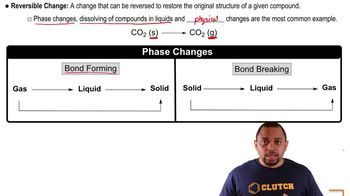Which of the following linear plots do you expect for a reaction A⟶products if the kinetics are a. zero order, [Section 14.3]
The following graph shows two different reaction pathways for the same overall reaction at the same temperature. Is each of the following statements true or false? (b) For both paths, the rate of the reverse reaction is slower than the rate of the forward reaction.

 Verified step by step guidance
Verified step by step guidance
Verified Solution
Key Concepts
Reaction Pathways

Forward and Reverse Reactions

Activation Energy

The accompanying graph shows plots of ln k versus 1>T for two different reactions. The plots have been extrapolated to the y-intercepts. Which reaction (red or blue) has (a) the larger value for Ea,
The accompanying graph shows plots of ln k versus 1/𝑇 for two different reactions. The plots have been extrapolated to the y-intercepts. Which reaction (red or blue) has b. the larger value for the frequency factor, A? [Section 14.4]
Consider the diagram that follows, which represents two steps in an overall reaction. The red spheres are oxygen, the blue ones are nitrogen, and the green ones are fluorine. d. Write the rate law for the overall reaction if the first step is the slow, rate-determining step. [Section 14.5]
Based on the following reaction profile, how many intermediates are formed in the reaction A⟶C? How many transition states are there? Which step, A⟶B or B⟶C, is the faster? For the reaction A⟶C, is Δ𝐸 positive, negative, or zero? [Section 14.5]
(b) Name three factors that can affect the rate of a chemical reaction.
